Bio-Innovative Modification of Poly(Ethylene Terephthalate) Fabric Using Enzymes and Chitosan
Abstract
:1. Introduction
2. Materials and Methods
2.1. Materials
2.2. Treatment Procedure
2.3. Characterization Methods
3. Results and Discussion
4. Conclusions
Author Contributions
Funding
Institutional Review Board Statement
Informed Consent Statement
Data Availability Statement
Acknowledgments
Conflicts of Interest
References
- Gawish, S.M.; Bourgeois, M.; Ambroise, G. Cationic Polymers for the Alkaline Saponification of Polyester Fabrics. Am. Dyest. Rep. 1985, 74, 35–36. [Google Scholar]
- Kallay, N.; Grancarić, A.M.; Tomić, M. Kinetics of Polyester Fibre Dissolution. Text. Res. J. 1990, 60, 663–668. [Google Scholar] [CrossRef]
- Grancarić, A.M.; Kallay, N. Kinetics of polyester fiber alkaline hydrolysis: Effect of temperature and cationic surfactants. J. Appl. Polym. Sci. 1993, 49, 175–181. [Google Scholar] [CrossRef]
- Grancarić, A.M.; Pušić, T.; Kallay, N. Modifikacija poliesterskog vlakna alkalnom hidrolizom. Polimeri 1991, 12, 141–145. [Google Scholar]
- Musale, R.M.; Shukla, S.R. Weight reduction of polyester fabric using sodium hydroxide solutions with additives cetyltrimethylammonium bromide and [BMIM]Cl. J. Text. Inst. 2017, 108, 467–471. [Google Scholar] [CrossRef]
- Cao, J.; Meng, C.; Cheng, X.; Pan, X. Surface alkali deweighting and dyeing of polyester fabric by one-bath and one-step process. Surf. Innov. 2019, 7, 104–111. [Google Scholar] [CrossRef]
- Čorak, I.; Tarbuk, A.; Đorđević, D.; Višić, K.; Botteri, L. Sustainable Alkaline Hydrolysis of Polyester Fabric at Low Temperature. Materials 2022, 15, 1530. [Google Scholar] [CrossRef]
- Pušić, T.; Kaurin, T.; Liplin, M.; Budimir, A.; Čurlin, M.; Grgić, K.; Sutlović, A.; Volmajer Valh, J. The Stability of the Chitosan Coating on Polyester Fabric in the washing process. Tekstilec 2023, 66, 85–104. [Google Scholar] [CrossRef]
- Guebitz, G.M.; Cavaco-Paulo, A. Enzymes go big: Surface hydrolysis and functionalization of synthetic polymers. Trends Biotechnol. 2008, 26, 32–38. [Google Scholar] [CrossRef]
- Quartinello, F.; Guebitz, G.M.; Ribitsch, D. Surface functionalization of polyester. Meth. Enzymol. 2019, 627, 339–360. [Google Scholar] [CrossRef]
- Wu, J.; Cai, G.; Liu, J.; Ge, H.; Wang, J. Eco-friendly surface modification on polyester fabrics by esterase treatment. Appl. Surf. Sci. 2014, 295, 150–157. [Google Scholar] [CrossRef]
- Rehman, A.; Raza, Z.A.; Masood, R. Optimization of lipase activity under various chemo-physical conditions for hydrolysis of polyester fabric using multiple statistical approaches. J. Text. Inst. 2020, 111, 826–834. [Google Scholar] [CrossRef]
- Abo El-Ola, S.M.; Moharam, M.E.; El-Bendary, M.A. Optimum conditions for surface modification of PET by lipase enzymes produced by Egyptian bacilli in comparison with standard one. Indian J. Fibre Text. Res. 2013, 38, 165–172. [Google Scholar]
- Karaca, B.; Ozdogan, E. A study on surface characterization of enzyme treated polyethylene terephthalate fibers by XPS and AFM. Text. Appar. 2013, 23, 16–22. [Google Scholar]
- Kardas, I.; Lipp.-Symonowicz, B.; Sztajnowski, S.; Wojciechowska, D. The influence of PET fibres surface enzymatic modification on the selected properties. Autex Res. J. 2014, 14, 179–186. [Google Scholar] [CrossRef]
- Donelli, I.; Taddei, P.; Smet, P.F.; Poelman, D.; Nierstrasz, V.A.; Freddi, G. Enzymatic surface modification and functionalization of PET: A water contact angle, FTIR, and fluorescence spectroscopy study. Biotechnol. Bioeng. 2009, 103, 845–856. [Google Scholar] [CrossRef]
- Tkavc, T.; Vesel, A.; Acero, E.H.; Fras Zemljič, L. Comparison of oxygen plasma and cutinase effect on polyethylene terephthalate surface. J. Appl. Polym. Sci. 2012, 128, 3570–3575. [Google Scholar] [CrossRef]
- Dong, Z.Q.; Chen, G.Q. Alkaline Hydrolysis of Polyester in the Presence of Ionic Liquids. Adv. Mater. Res. 2012, 441, 661–665. [Google Scholar] [CrossRef]
- Hsieh, Y.L. Surface Characteristics of Polyester Fibers. In Surface Characteristics of Fibers and Textiles, 1st ed.; Pastore, C., Kiekens, P., Eds.; Marcel Dekker: Basel, Switzerland, 2001; Chapter 2; pp. 33–58. [Google Scholar]
- Tkavc, T.; Petrinič, I.; Luxbacher, T.; Vesel, A.; Ristić, T.; Fras Zemljič, L. Influence of O2 and CO2 plasma treatment on the deposition of chitosan onto polyethylene terephthalate (PET) surfaces. Int. J. Adhes. Adhes. 2014, 48, 168–176. [Google Scholar] [CrossRef]
- Bakshi, P.S.; Selvakumar, D.; Kadirvelu, K.; Kumar, N.S. Chitosan as an environment friendly biomaterial—A review on recent modifications and applications. Int. J. Biol. Macromol. 2020, 150, 1072–1083. [Google Scholar] [CrossRef]
- Shahid-ul-Islam; Butola, B.S. Recent advances in chitosan polysaccharide and its derivatives in antimicrobial modification of textile materials. Int. J. Biol. Macromol. 2019, 121, 905–912. [Google Scholar] [CrossRef] [PubMed]
- Verlee, A.; Mincke, S.; Stevens, C.V. Recent development in antibacterial and antifungal chitosan and its derivatives. Carbohydr. Polym. 2017, 164, 268–283. [Google Scholar] [CrossRef]
- Shabbir, M.; Rather, L.J.; Mohammad, F. Chitosan: Sustainable and Environmental-Friendly Resource for Textile Industry. In Chitosan: Derivatives, Composites and Applications; Ahmed, S., Ikram, S., Eds.; Scrivener Publishing: Beverly, MA, USA, 2017; Chapter 9; pp. 233–252. [Google Scholar] [CrossRef]
- Picos-Corrales, L.A.; Morales-Burgos, A.M.; Ruelas-Leyva, J.P.; Crini, G.; García-Armenta, E.; Jimenez-Lam, S.A.; Ayón-Reyna, L.E.; Rocha-Alonzo, F.; Calderón-Zamora, L.; Osuna-Martínez, U.; et al. hitosan as an outstanding polysaccharide improving health-commodities of humans and environmental protection. Polymers 2023, 15, 526. [Google Scholar] [CrossRef] [PubMed]
- Furuike, T.; Komoto, D.; Hashimoto, H.; Tamura, H. Preparation of chitosan hydrogel and its solubility in organic acids. Int. J. Biol. Macromol. 2017, 104, 1620–1625. [Google Scholar] [CrossRef] [PubMed]
- Sikorski, D.; Gzyra-Jagiela, K.; Draczynski, Z. The Kinetics of Chitosan Degradation in Organic Acid Solutions. Mar. Drugs 2021, 19, 236. [Google Scholar] [CrossRef]
- Fras Zemljič, L.; Bračič, M.; Ristić, T.; Šauperl, O.; Strnad, S.; Peršin, Z. Functionalization of polymer materials for medical applications using chitosan nanolayers. In Polymeric Nanomaterials in Nanotherapeutics; Vasile, C., Ed.; Elsevier: Amsterdam, The Netherlands, 2019; Chapter 9; pp. 333–358. [Google Scholar] [CrossRef]
- Simončič, B.; Tomšič, B. Structures of Novel Antimicrobial Agents for Textiles—A Review. Text. Res. J. 2010, 80, 1721–1737. [Google Scholar] [CrossRef]
- Flinčec Grgac, S.; Tarbuk, A.; Dekanić, T.; Sujka, W.; Draczyński, Z. The Chitosan Implementation into Cotton and Polyester/Cotton Blend Fabrics. Materials 2020, 13, 1616. [Google Scholar] [CrossRef]
- Flinčec Grgac, S.; Biruš, T.-D.; Tarbuk, A.; Dekanić, T.; Palčić, A. The Durable Chitosan Functionalization of Cellulosic Fabrics. Polymers 2023, 15, 3829. [Google Scholar] [CrossRef]
- Flinčec Grgac, S.; Biruš, T.-D.; Tarbuk, A.; Dekanić, T.; Palčić, A. Postojana obrada pamučne i pamuk/poliesterske tkanine s biopolimerom kitozana. Godišnjak Akad. Teh. Znan. Hrvat. 2023, 1, 221–234. Available online: https://hrcak.srce.hr/317696 (accessed on 5 May 2024).
- Flinčec Grgac, S.; Tesla, T.; Čorak, I.; Žuvela Bošnjak, F. Hydrothermal Synthesis of Chitosan and Tea Tree Oil on Plain and Satin Weave Cotton Fabrics. Materials 2022, 15, 5034. [Google Scholar] [CrossRef]
- Tang, W.; Wang, J.; Hou, H.; Li, Y.; Wang, J.; Fu, J.; Lu, L.; Gao, D.; Liu, Z.; Zhao, F.; et al. Review: Application of chitosan and its derivatives in medical materials. Int. J. Biol. Macromol. 2023, 240, 124398. [Google Scholar] [CrossRef] [PubMed]
- Kim, J.H.; Lee, S.Y. Surface Modification of PET Film and Fabric by Oligo-Chitosan Treatment. Fibers Polym. 2014, 15, 2489–2494. [Google Scholar] [CrossRef]
- Ҫaykara, T.; Sande, M.G.; Azoia, N.; Rodrigues, L.R.; Silva, C.J. Exploring the potential of polyethylene terephthalate in the design of antibacterial surfaces. Med. Microbiol. Immunol. 2020, 209, 363–372. [Google Scholar] [CrossRef]
- Wieckiewicz, M.; Wolf, E.; Richter, G.; Meissner, H.; Boening, K. New Concept of Polymethyl Methacrylate (PMMA) and Polyethylene Terephthalate (PET) Surface Coating by Chitosan. Polymers 2016, 8, 132. [Google Scholar] [CrossRef]
- Sikorski, D.; Bauer, M.; Frączyk, J.; Draczyński, Z. Antibacterial and Antifungal Properties of Modified Chitosan Nonwovens. Polymers 2022, 14, 1690. [Google Scholar] [CrossRef]
- Hosseinnejad, M.; Jafari, S.M. Evaluation of different factors affecting antimicrobial properties of chitosan. Int. J. Biol. Macromol. 2016, 85, 467–475. [Google Scholar] [CrossRef]
- Ke, C.L.; Deng, F.S.; Chuang, C.Y.; Lin, C.H. Antimicrobial actions and applications of chitosan. Polymers 2021, 13, 904. [Google Scholar] [CrossRef]
- Zhang, W.; Zhang, J.; Xia, W. Effect of Ball-Milling Treatment on Physicochemical and Structural Properties of Chitosan. Int. J. Food Prop. 2014, 17, 26–37. [Google Scholar] [CrossRef]
- Hassan, M.I.; Mohamed, A.F.; Taher, F.A.; Kamel, M.R. Chitosan nanoparticles prepared from Lucilia Cuprina Maggots as antibacterial agent. J. Egypt. Soc. Parasitol. 2016, 46, 519–526. [Google Scholar]
- Čorak, I. Bio-innovated polyester material aimed for use in a hospital environment. In Proceedings of the PhD Students’ Day 2024, Sicily, Italy, 6–9 May 2024; University of Zagreb Faculty of Textile Technology: Zagreb, Croatia, 2024; pp. 173–175. [Google Scholar]
- Dekanić, T.; Basić, M.; Palčić, A.; Flinčec Grgac, S.; Tarbuk, A.; Grgić, K. Influence of optimized washing process on antimicrobial treated textiles. In Proceedings of the 15th Scientific–Professional Symposium Textile Science & Economy, Sustainable Fashion, Textiles and Green Technologies in the Context of Circular Economy, Zagreb, Croatia, 26 January 2023; University of Zagreb Faculty of Textile Technology: Zagreb, Croatia, 2023; pp. 120–125. [Google Scholar]
- Luxbacher, T.; Pušić, T.; Bukšek, H.; Petrinić, I. The zeta potential of textile fabrics: A review. Tekstil 2016, 65, 346–351. Available online: https://hrcak.srce.hr/186570 (accessed on 5 March 2024).
- Grancarić, A.M.; Tarbuk, A.; Pušić, T. Electrokinetic properties of textile fabrics. Color. Technol. 2005, 121, 221–227. [Google Scholar] [CrossRef]
- Grancarić, A.M.; Chibowski, E.; Tarbuk, A. Surface Free Energy of Textile (In Croatian Slobodna površinska energija tekstila). Tekstil 2008, 57, 29–39. Available online: https://hrcak.srce.hr/35482 (accessed on 5 March 2024).
- Tarbuk, A.; Flinčec Grgac, S.; Dekanić, T. Wetting and wicking of hospital protective textiles. Adv. Technol. 2019, 8, 5–15. [Google Scholar] [CrossRef]
- Chen, Z.; Hay, J.N.; Jenkins, M.J. FTIR spectroscopic analysis of poly(ethylene terephthalate) on crystallization. Eur. Polym. J. 2012, 48, 1586–1610. [Google Scholar] [CrossRef]
- Chen, Z.; Hay, J.N.; Jenkins, M.J. The thermal analysis of poly(ethylene terephthalate) by FTIR spectroscopy. Thermochim. Acta 2013, 552, 123–130. [Google Scholar] [CrossRef]
- Dave, H.; Ledwani, L.; Chandwani, N.; Kikani, P.; Desai, B.; Nema, S.K. Surface Modification of Polyester Fabric by Non-Thermal Plasma Treatment and Its Effect on Coloration Using Natural Dye. J. Polym. Mater. 2013, 30, 291–304. [Google Scholar]
- Dos Santos Pereira, A.P.; Prado da Silva, M.H.; Pereira Lima Júnior, É.; Dos Santos Paula, A.; Tommasini, F.J. Processing and Characterization of PET Composites Reinforced With Geopolymer Concrete Waste. Mater. Res. 2017, 20, 411–420. [Google Scholar] [CrossRef]
- Šauperl, O.; Fras Zemljič, L.; Volmajer Valh, J.; Tompa, J. Assessment of chemically and enzymatically modified chitosan with eugenol as a coating for viscose functionalization for potential medical use. Text. Res. J. 2021, 91, 2813–2832. [Google Scholar] [CrossRef]
- Jacobasch, H.J.; Bauböck, G.; Schurz, J. Problems and results of zeta potential measurements on fibres. Colloid Polym. Sci. 1985, 263, 3–24. [Google Scholar] [CrossRef]
- Luxbacher, T. Electrokinetic Properties of Natural Fibres. In Handbook of Natural Fibres, 2nd ed.; Kozłowski, R.M., Mackiewicz-Talarczyk, M., Eds.; Woodhead Publishing: Cambridge, UK, 2020; Volume 2: Processing and Applications, The Textile Institute Book Series; pp. 323–353. [Google Scholar] [CrossRef]
- Isaad, J.; El Achari, A. Chitosan-coated nonwoven polyethylene terephthalate material for efficient removal of cationic and anionic dyes from aqueous solution. Int. J. Environ. Anal. 2022, 102, 5472–5494. [Google Scholar] [CrossRef]
- Čorak, I.; Tarbuk, A.; Kuduzović, V.; Meheš, I.; Višić, K. The influence of process parameters on the polyester hydrolysis by amanolipases. In Proceedings of the 15th Scientific–Professional Symposium Textile Science & Economy, Sustainable Fashion, Textiles and Green Technologies in the Context of Circular Economy, Zagreb, Croatia, 26 January 2023; University of Zagreb Faculty of Textile Technology: Zagreb, Croatia, 2023; pp. 97–102. [Google Scholar]

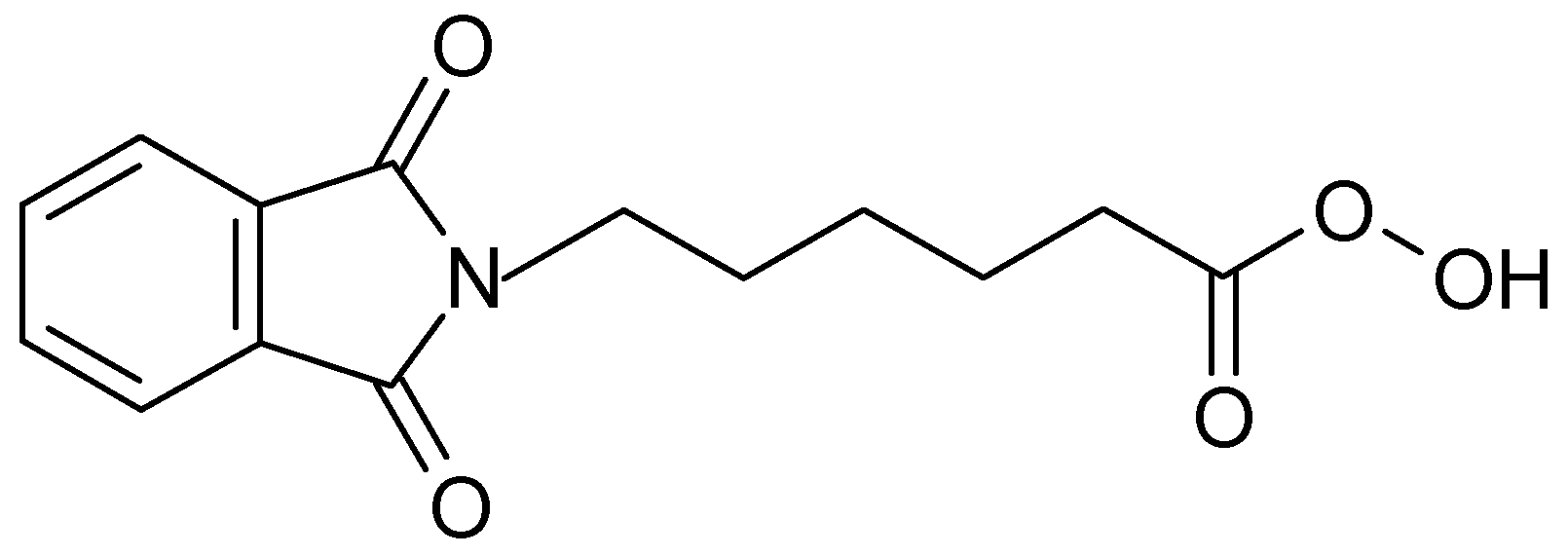
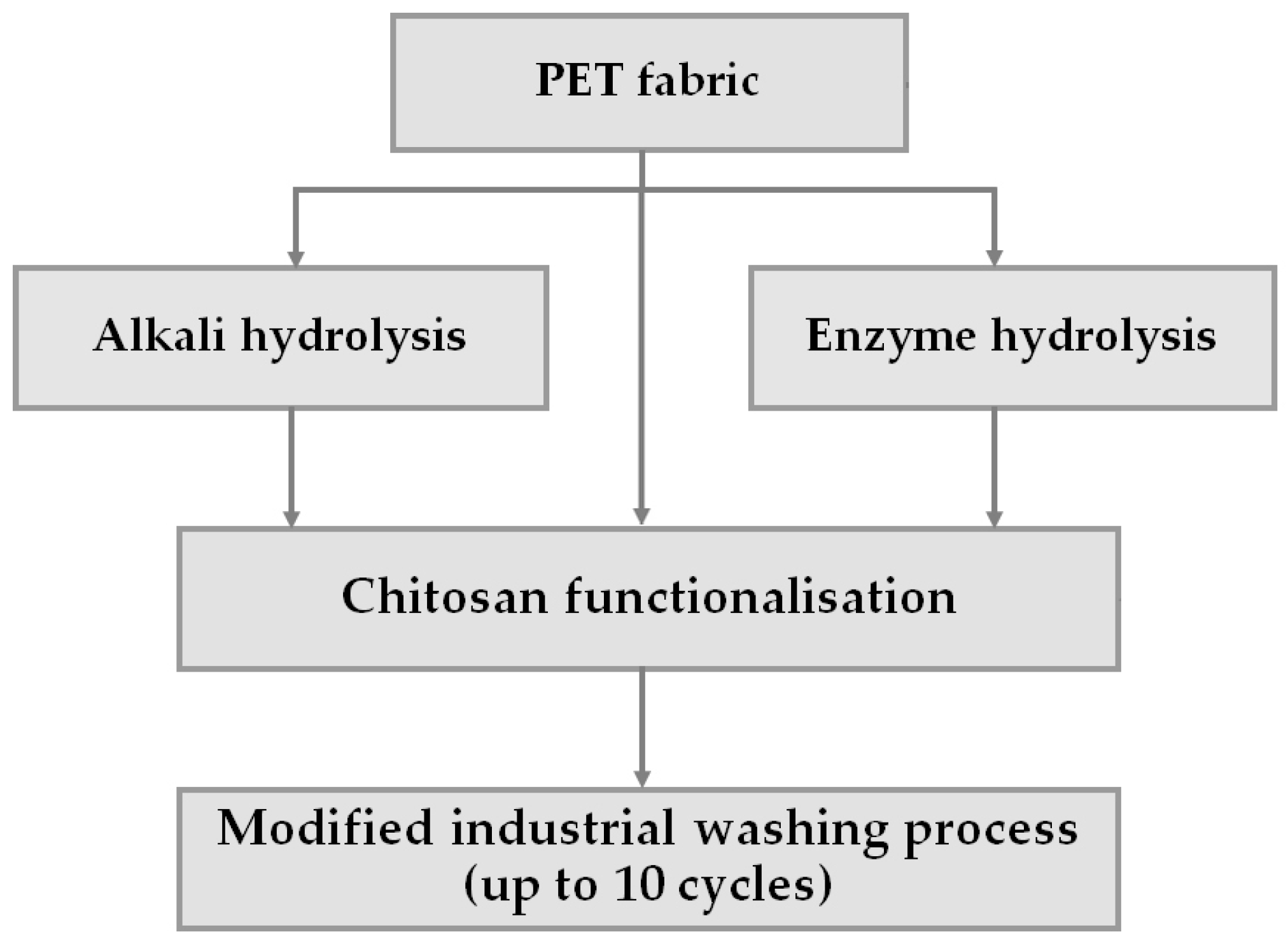
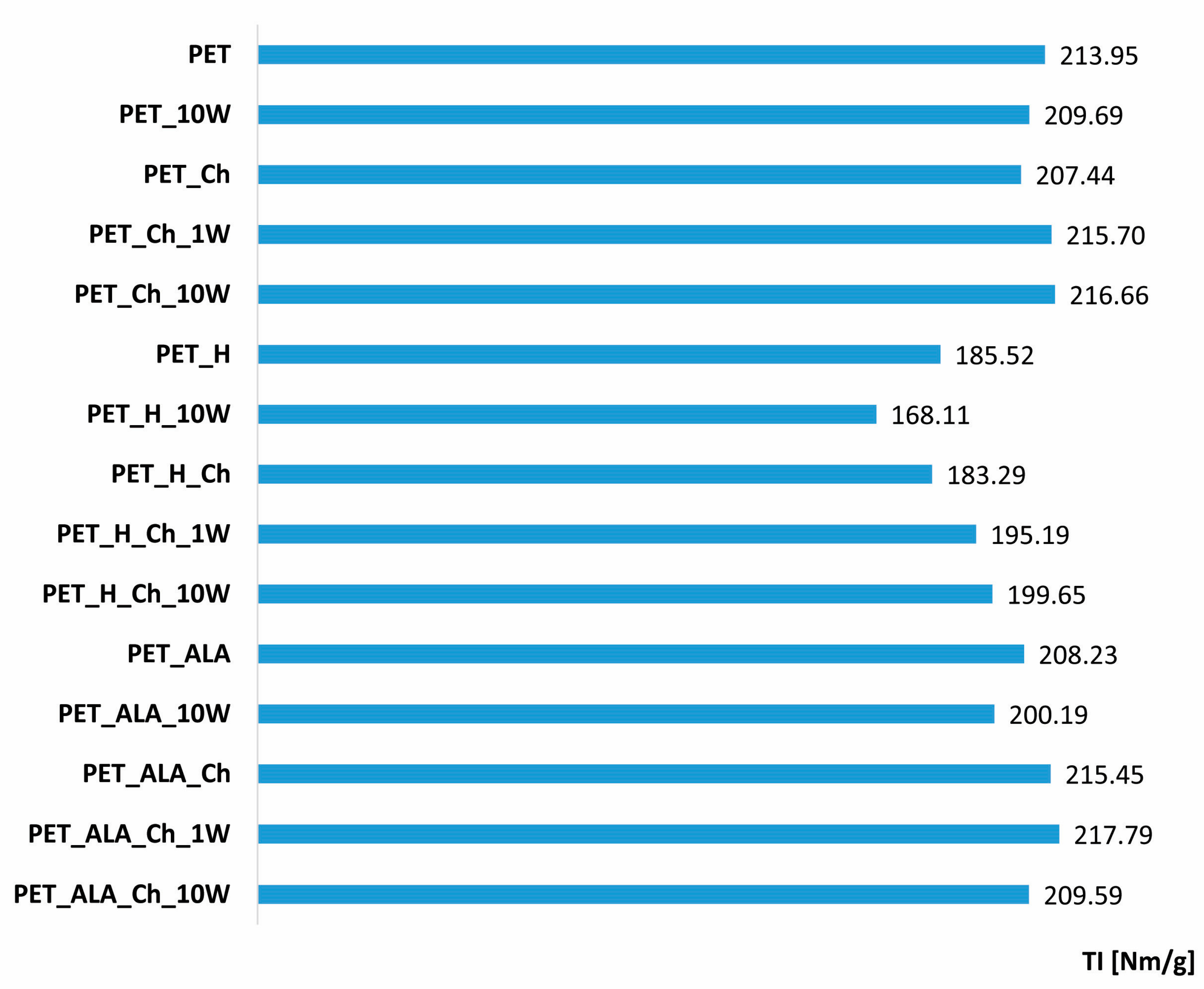

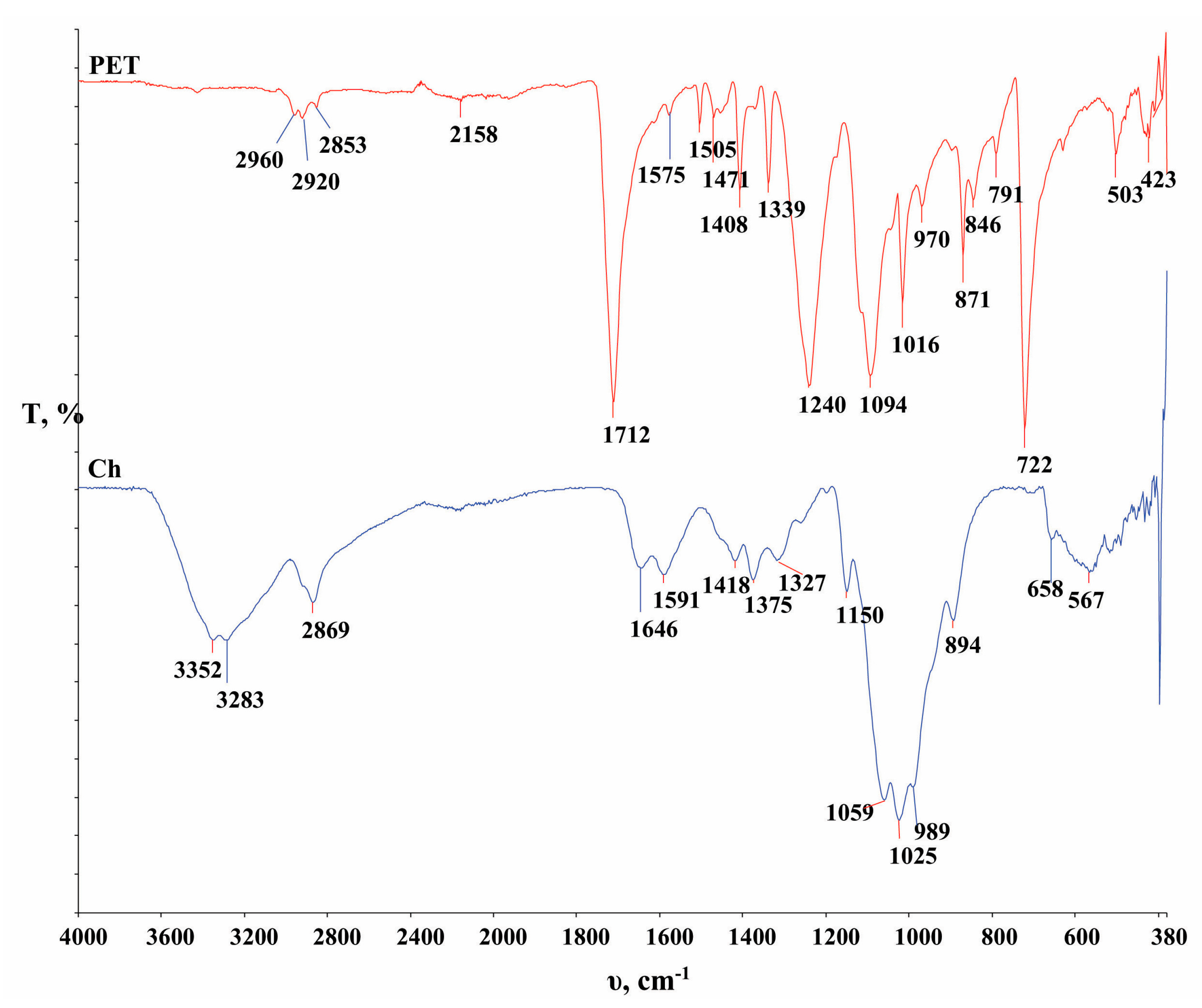
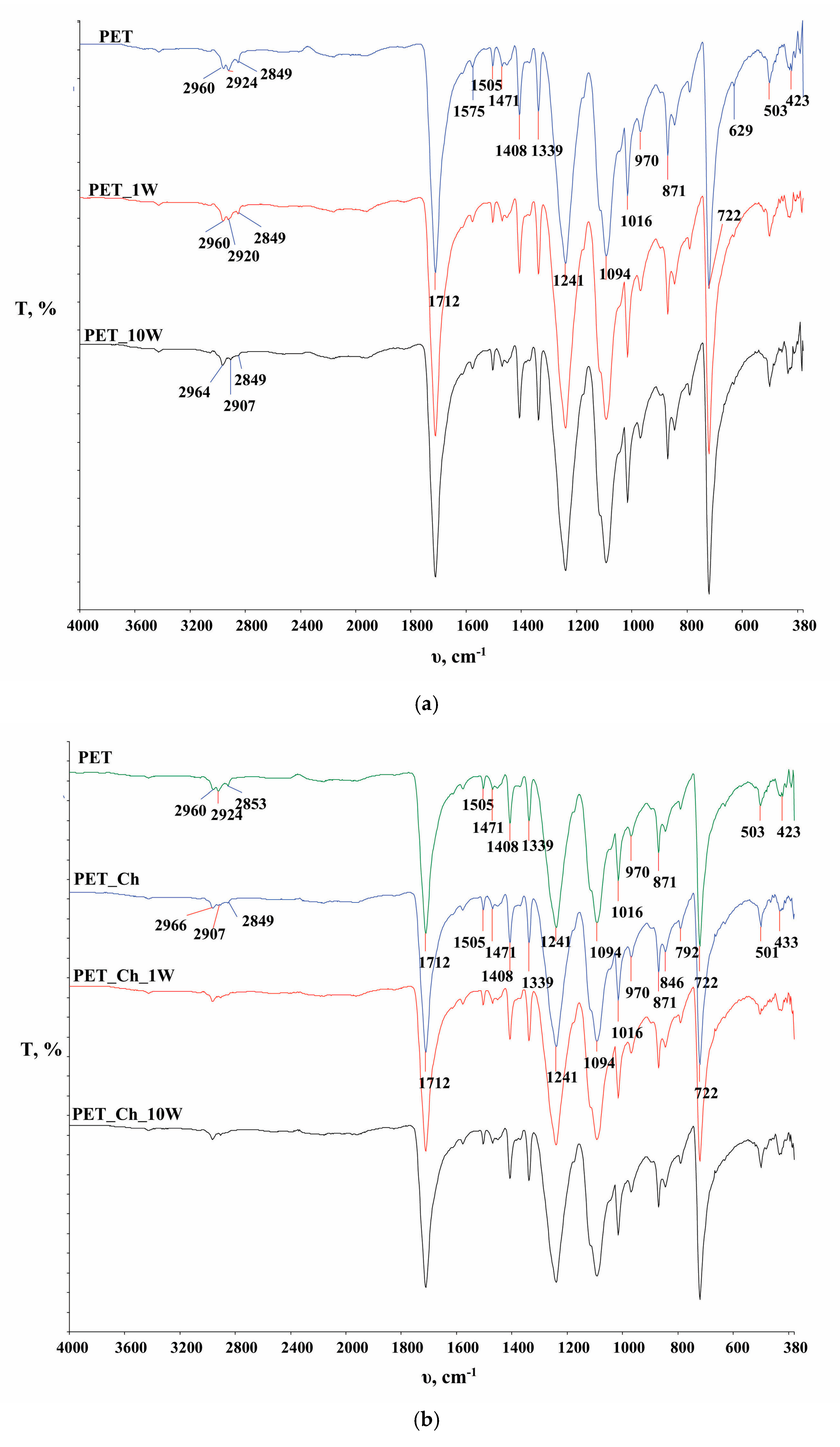
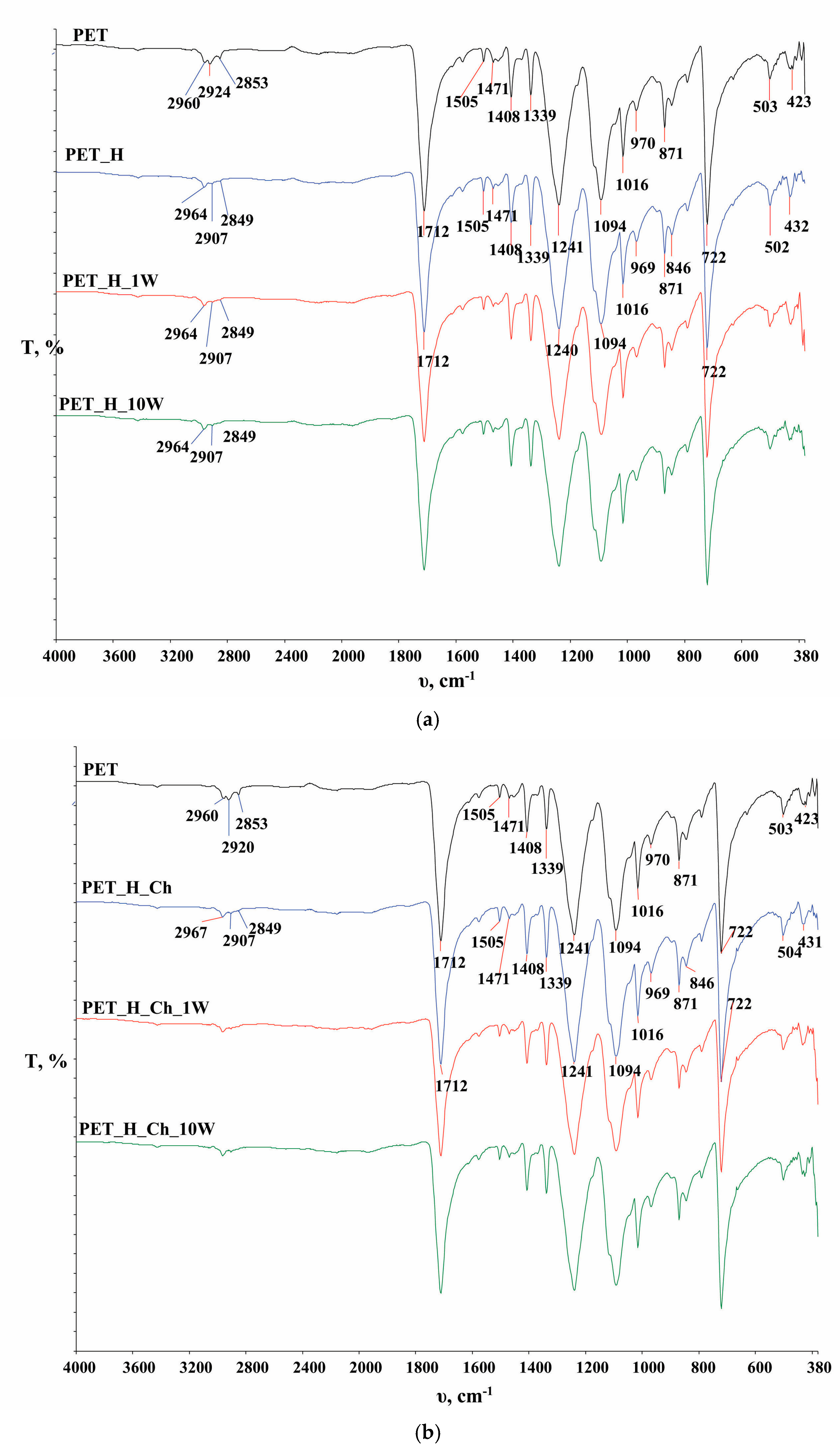
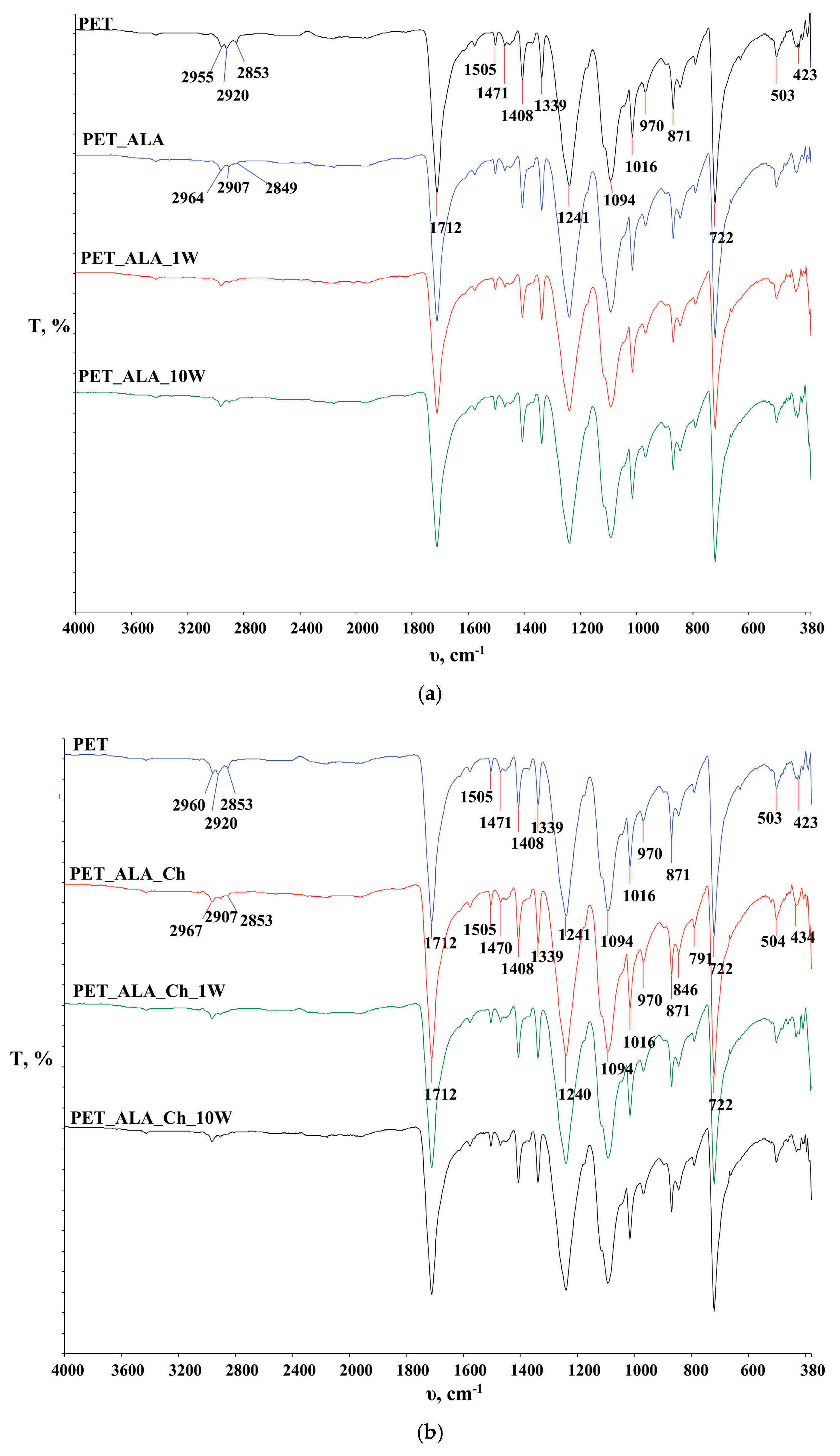


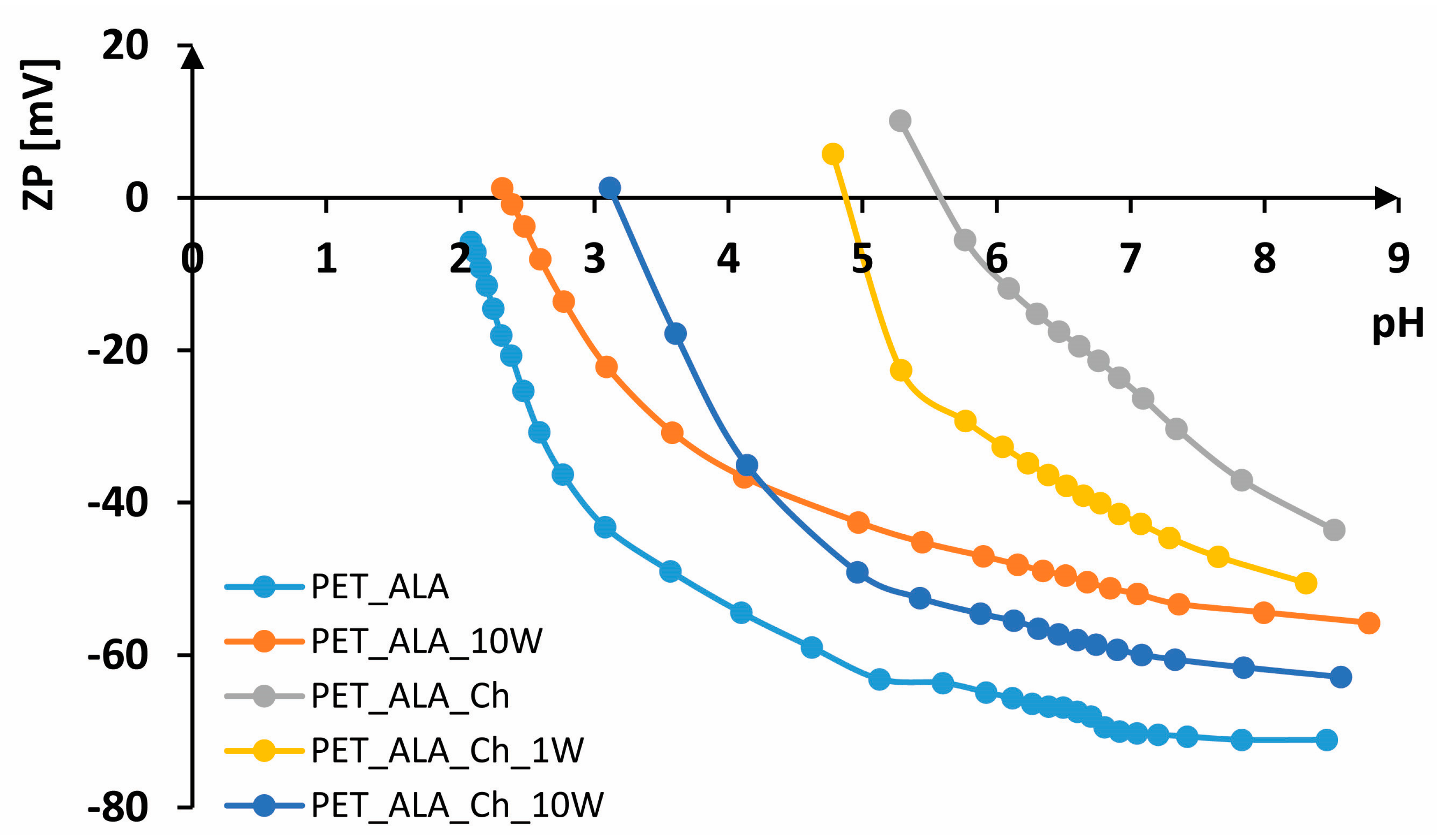
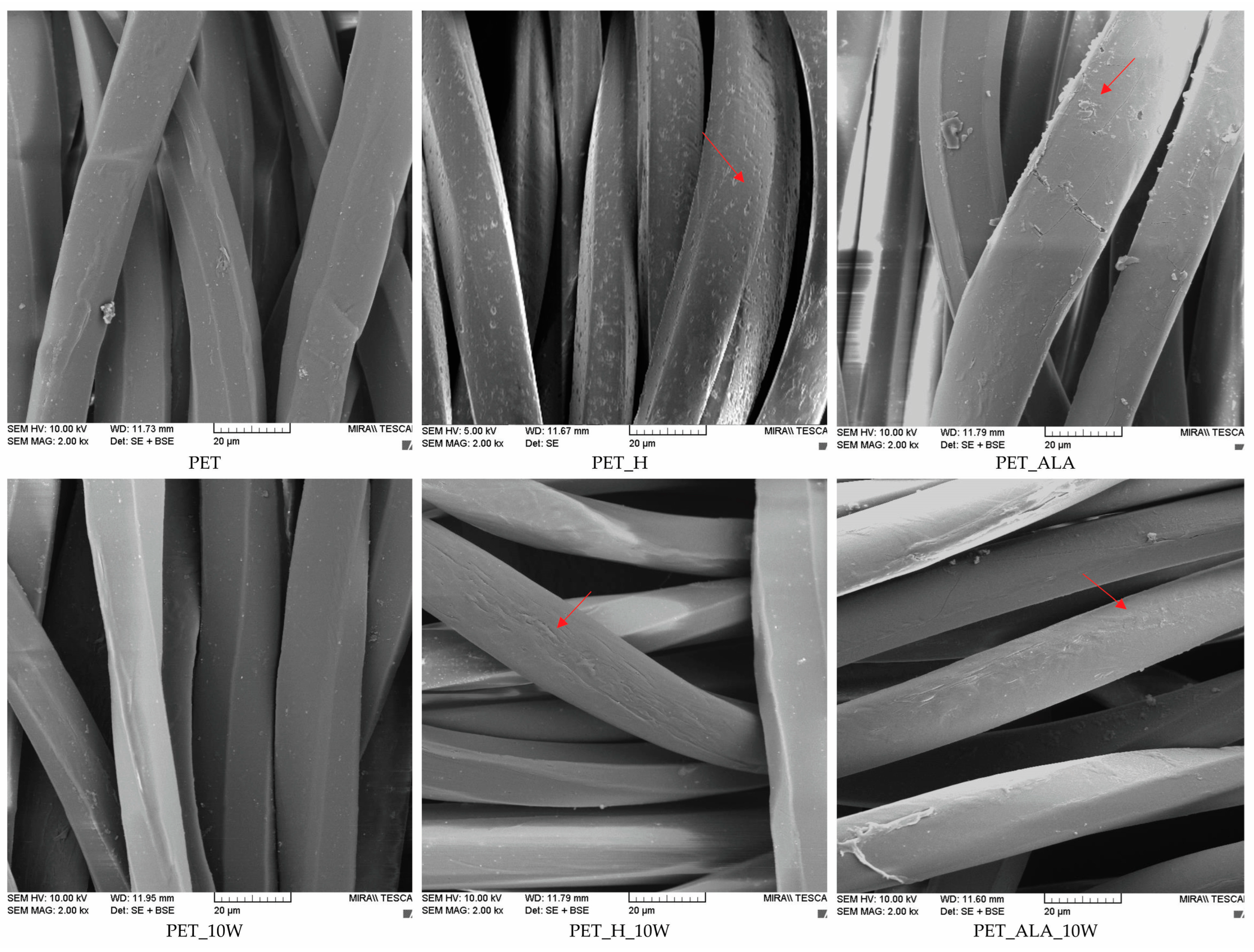
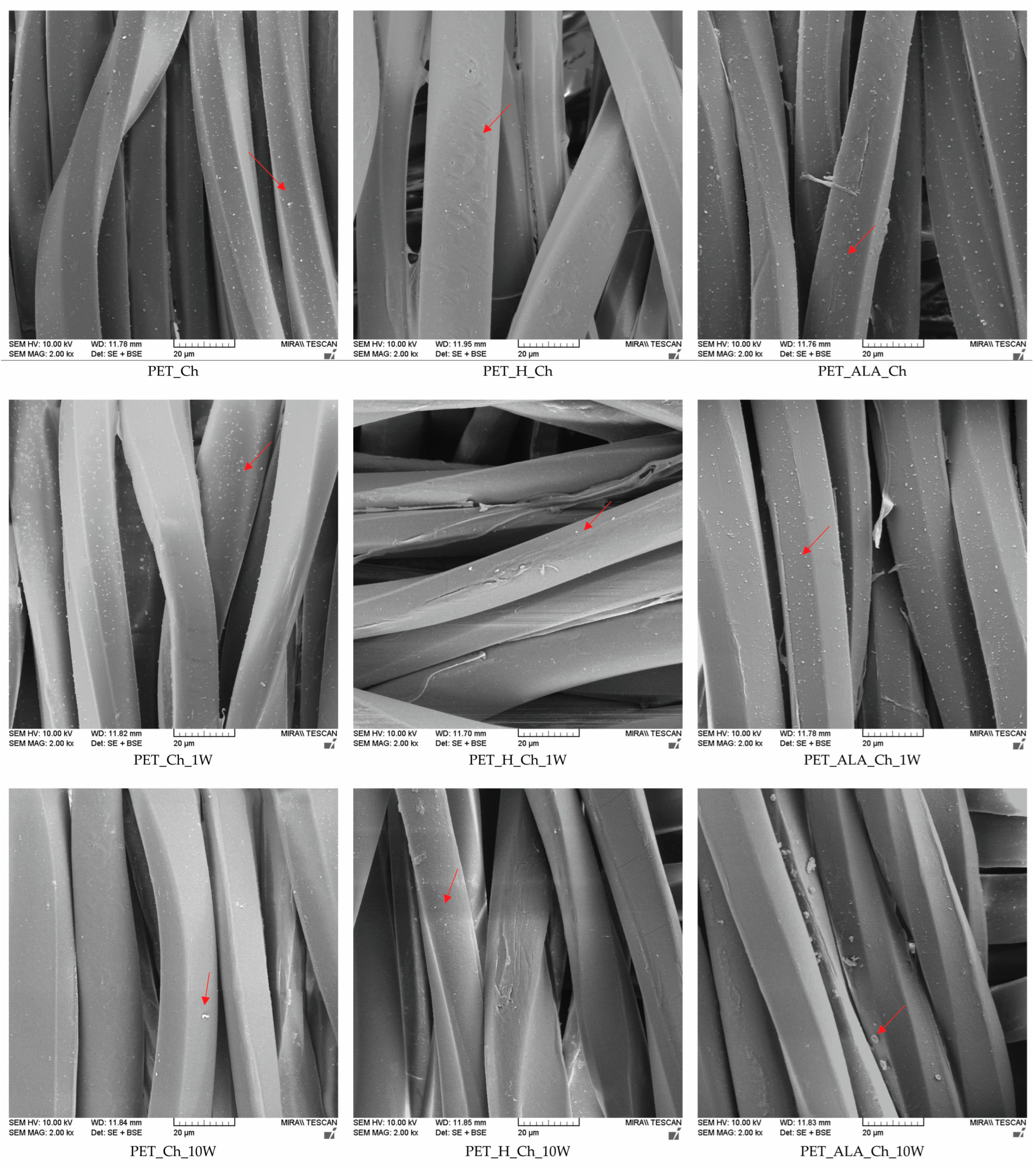
| Label | Treatment |
|---|---|
| PET | Untreated PET fabric |
| _H | Alkaline hydrolysis with accelerator HDTMAC |
| _ALA | Enzymatic hydrolysis with Amano Lipases |
| _Ch | Chitosan functionalization |
| _1W or _10W | First or tenth washing cycle |
| Sample | m [g/m2] | Δm [%] | F [N] | ΔF [%] | ε [%] | Δε [%] |
|---|---|---|---|---|---|---|
| PET | 61.23 | - | 655.00 | - | 29.16 | - |
| PET_10W | 62.57 | 2.19 | 656.00 | 0.15 | 33.55 | 15.05 |
| PET_Ch | 64.02 | 4.56 | 664.00 | 1.37 | 31.80 | 9.05 |
| PET_Ch_1W | 62.91 | 2.74 | 678.50 | 3.59 | 31.90 | 9.40 |
| PET_Ch_10W | 62.68 | 2.37 | 679.00 | 3.66 | 30.60 | 4.94 |
| PET_H | 56.92 | −7.04 | 528.00 | −19.39 | 26.70 | −8.44 |
| PET_H_10W | 57.64 | −5.86 | 484.50 | −26.03 | 27.80 | −4.63 |
| PET_H_Ch | 59.47 | −2.87 | 545.00 | −16.79 | 27.42 | −5.97 |
| PET_H_Ch_1W | 59.02 | −3.61 | 576.00 | −12.06 | 24.26 | −16.80 |
| PET_H_Ch_10W | 57.25 | −6.50 | 571.50 | −12.75 | 30.00 | 2.88 |
| PET_ALA | 62.72 | 2.43 | 653.00 | −0.31 | 35.48 | 21.67 |
| PET_ALA_10W | 61.94 | 1.16 | 620.00 | −5.34 | 32.60 | −6.65 |
| PET_ALA_Ch | 63.54 | 3.77 | 684.50 | 4.50 | 30.45 | 4.42 |
| PET_ALA_Ch_1W | 64.74 | 5.73 | 705.00 | 7.63 | 32.00 | 9.77 |
| PET_ALA_Ch_10W | 65.08 | 6.29 | 682.00 | 4.12 | 32.80 | 12.48 |
| Fabric | S. aureus | E. coli | C. albicans |
|---|---|---|---|
| PET | − | − | − |
| PET_10W | +/− | +/− | − |
| PET_Ch | +/− | +/− | +/− |
| PET_Ch_1W | +/− | +/− | − |
| PET_Ch_10W | +/− | +/− | − |
| PET_H | + | +/− | − |
| PET_H_10W | +/− | +/− | − |
| PET_H_Ch | + | +/− | +/− |
| PET_H_Ch_1W | +/− | +/− | − |
| PET_H_Ch_10W | +/− | +/− | − |
| PET_ALA | +/− | +/− | − |
| PET_ALA_10W | +/− | +/− | − |
| PET_ALA_Ch | +/− | +/− | +/− |
| PET_ALA_Ch_1W | +/− | +/− | +/− |
| PET_ALA_Ch_10W | +/− | +/− | − |
Disclaimer/Publisher’s Note: The statements, opinions and data contained in all publications are solely those of the individual author(s) and contributor(s) and not of MDPI and/or the editor(s). MDPI and/or the editor(s) disclaim responsibility for any injury to people or property resulting from any ideas, methods, instructions or products referred to in the content. |
© 2024 by the authors. Licensee MDPI, Basel, Switzerland. This article is an open access article distributed under the terms and conditions of the Creative Commons Attribution (CC BY) license (https://creativecommons.org/licenses/by/4.0/).
Share and Cite
Čorak, I.; Tarbuk, A.; Flinčec Grgac, S.; Dekanić, T. Bio-Innovative Modification of Poly(Ethylene Terephthalate) Fabric Using Enzymes and Chitosan. Polymers 2024, 16, 2532. https://doi.org/10.3390/polym16172532
Čorak I, Tarbuk A, Flinčec Grgac S, Dekanić T. Bio-Innovative Modification of Poly(Ethylene Terephthalate) Fabric Using Enzymes and Chitosan. Polymers. 2024; 16(17):2532. https://doi.org/10.3390/polym16172532
Chicago/Turabian StyleČorak, Ivana, Anita Tarbuk, Sandra Flinčec Grgac, and Tihana Dekanić. 2024. "Bio-Innovative Modification of Poly(Ethylene Terephthalate) Fabric Using Enzymes and Chitosan" Polymers 16, no. 17: 2532. https://doi.org/10.3390/polym16172532






